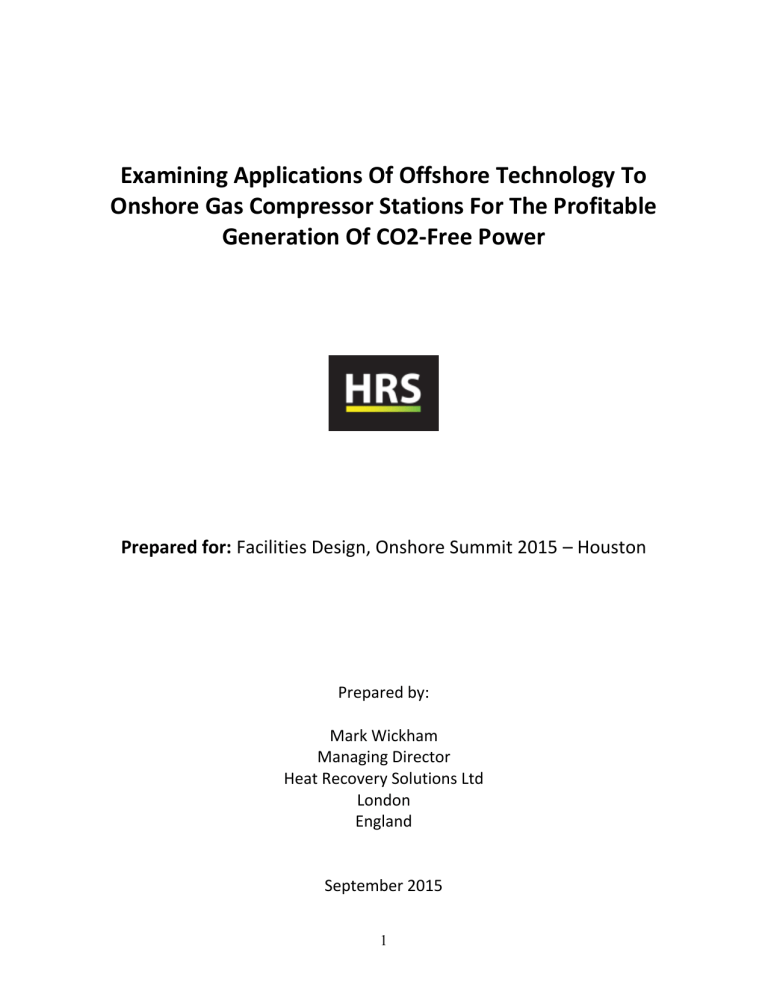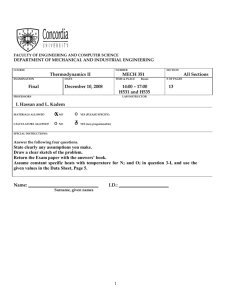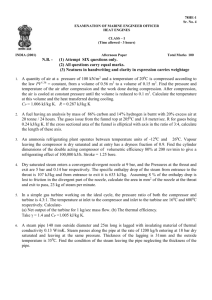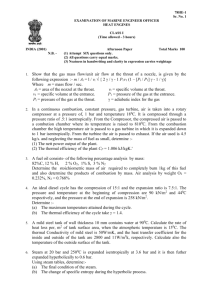Examining Applications Of Offshore Technology To Onshore Gas

Examining Applications Of Offshore Technology To
Onshore Gas Compressor Stations For The Profitable
Generation Of CO2-Free Power
Prepared for: Facilities Design, Onshore Summit 2015 – Houston
Prepared by:
Mark Wickham
Managing Director
Heat Recovery Solutions Ltd
London
England
September 2015
1
TABLE OF CONTENTS
1.
EXECUTIVE SUMMARY
2.
INTRODUCTION
3.
REVIEW OF THE ENABLING TECHNOLOGY: WHY AND HOW IT WAS DEVELOPED
OFFSHORE AND WHAT THE TRANSFERABLE APPLICATIONS ARE ONSHORE
3.1
WHY IT WAS DEVELOPED
3.2
HOW IT WAS DEVELOPED
3.3
TRANSFERABLE APPLICATIONS
4.
ASSESSMENT OF HOW THE TECHNOLOGY CAN BE APPLIED TO ONSHORE
COMPRESSOR STATIONS TO ACHIEVE LOW COST, EMISSIONS FREE POWER
4.1
BACKGROUND ON US COMPRESSOR STATIONS
4.2
POTENTIAL IMPACT OF HRS TECHNOLOGY
5.
EXAMINING THE EXTENT TO WHICH ONSHORE COMPRESSOR STATIONS
CONTRIBUTE TO ACHIEVING THE US GOVERNMENT’s TARGET ON CO
2
REDUCTIONS
5.1
US GOVERNMENT’s CO
2
REDUCTION TARGET
5.2
THE EXTENT TO WHICH CONVERTING TO COMBINED CYCLE COULD AFFECT THE
TARGET
6.
EVALUATING THE PROFITABILITY OF ONSHORE APPLICATIONS
6.1
PROFITABILITY ONSHORE
6.2 TYPICAL EXAMPLE FOR A 2 x 15,000HP GAS COMPRESSOR STATION
7.
CONCLUSIONS
2
1.
EXECUTIVE SUMMARY
Solutions for power generation from gas turbine waste heat, developed for offshore platforms, can provide significant financial benefits for onshore facilities, particularly on gas compressor stations, as well as contributing to U.S. CO
2
reduction targets.
Financially, the HRS patented modular approach to generating power from waste heat averages $2,000 - $2,500 per kW/h CAPEX, compared to traditional onshore solutions at between $3,000 - $3,500 per kW/h. This cost difference means that the
90 - 100 projects identified by INGAA (Interstate Natural Gas Association of America) could be more profitable as well as making up to 100 additional projects viable.
The technology, which is fast build and can be installed on gas turbines with only one day outage, could facilitate up to 1000MW of zero emissions power generation, displacing equivalent power generation from fossil fuel plants and make a contribution of more than 1% to U.S. targets for emissions reduction from power generation.
The HRS modular approach with unmanned operation means that the more efficient steam rankine cycle is more profitable than organic rankine cycle for all gas turbine applications, as well as delivering much better CO
2
reductions.
2.
INTRODUCTION
Oil and Gas Platforms have a requirement for electrical and compression power as well as heat, to extract and process hydrocarbons. On early platforms power was produced by gas turbines and heat produced by fired heaters, as independent operations. In the early 80’s the production of heat from gas turbine exhausts was first introduced in the North Sea on Tyra West and East Platforms. The benefits of utilising waste heat to save fuel, reduce emissions and improving safety were soon realised by the industry and today most platforms with gas turbines produce heat in this way.
In many platforms, particularly those producing gas, there is a limited requirement for heat and it is common that none is recovered, although there are examples where gas sweetening is required. In 1999 the Norwegian Government introduced a carbon tax which made it possible for developers to consider installing combined cycle, by adding heat recovery steam generators on the exhausts with a steam turbine generator, producing up to 40% more power from the same fuel or the same power with less fuel. During the next few years, before the tax was significantly
3
reduced three platforms were built in this way - Eldfisk, Snorre B and Oseberg with power on the steam cycle ranging from 10-15MWe, mostly on LM2500 GT’s.
Installing combined cycles on these platforms proved challenging and all HRSG’s have been replaced in recent years. Last year HRS replaced the units on Conoco
Phillips Eldfisk platform based on their circular HRSG technology. It is understood this is the only platform operating in combined cycle anywhere in the world, this plant produces all the platform’s electrical needs, of nearly 10MWe.
The main challenges resulted from the need to have a small footprint and low weight, as is the case for all offshore heat recovery units whether for steam or process heat.
The technology developed by HRS for offshore has a number of features which could be of benefit onshore, in particular the modular approach, small footprint, standardisation, fast build and lower cost. This report aims to capture these benefits and to provide awareness to onshore developers that there may be a different approach, especially on gas compressor stations in the US, of which there are more than 1,200, providing a vast source of CO
2 free power that cannot, under traditional methods, be recovered economically.
The methodology developed for HRSG’s offshore has also been used to develop a steam turbine power module to complete the steam cycle and make it a simple and cost effective package.
3.
REVIEW OF THE ENABLING TECHNOLOGY: WHY AND HOW IT WAS DEVELOPED
OFFSHORE AND WHAT THE TRANSFERABLE APPLICATIONS ARE ONSHORE
3.1
WHY IT WAS DEVELOPED
In order to reduce the cost of offshore platforms the topside weight and size has to be minimised. Early gas turbine waste heat recovery units (WHRU’s) were designed to API 560, a robust and well proven fired heater standard. There was also a requirement to bypass the heat recovery unit for start up and also to control the amount of heat recovered in the heat exchanger. This required a pair of exhaust gas dampers to modulate and control the process fluid to a temperature set point. In addition a silencer was required between the gas turbine and the WHRU. The result was a set of casings, ducts, dampers and stacks that had to be assembled on the platform with suitably designed structures to support them.
The type of process fluids used to recover heat depends very much on the process requirements. Typically for heating crude oil to aid separation of water
4
and sand and to reduce pump pressure hot water or organic thermal fluid are used up to 300 o F. For amine systems to reduce sulphur content higher temperatures are required for regeneration in the order of 600 o F which require synthetic thermal fluids that can withstand higher temperatures without degradation. For combined cycles steam is required at typically 750 o F and 580psi to ensure a high degree of efficiency from the steam turbine.
During the late 80’s improvements were made to make the WHRU’s more compact with the introduction in the North Sea of the integral bypass, this helped by having the dampers, bypass and heat exchanger in an assembled form, however the silencer and stacks were still supplied separately.
Fig1 – Integral bypass WHRU’s
Generally WHRU’s are still designed to API 560 however today this really only applies to the heat exchanger and method of support ie tubesheets. Internal refractories were changed to ceramic fibre with stainless steel shroud to protect the fibres from erosion.
However continuing demand for reduced weight, plot space and shipyard assembly time required a complete rethink and a radical new designed evolved, developed by the people at HRS.
3.2
HOW IT WAS DEVELOPED
It started with the concept that this had to be a single assembly to reduce installation time and cost. It had to incorporate the heat exchanger, bypass, silencer and stack. It also had to minimise the amount of steel required to reduce
5
weight and be the smallest footprint possible. Support structures were also a big issue, especially on floating platforms such as FPSO’s where motion added considerably to the weight of the structures and if possible the centre of gravity should be lowered. Wind loading was also a factor, traditionally WHRU’s have been rectangular in shape similar to the convective section on fired heaters with a wind load factor of 1.0.
The question of what shape could be utilised to meet this criteria. Circular appeared to be ideal, however there was the major problem that finned heat exchanger tubes had never been coiled before.
A WHRU’s size is determined by exhaust gas velocity and pressure drop (typically
110ft/s and 12” water gauge). On this basis a circular WHRU would require 12% less steel to contain the gas and only 15% stiffening compared to 30% on rectangular units. It would also have a wind load factor of 0.6 which would save weight on the structure. Overall weight savings of up to 25% were possible.
The advantage of a circular coil is there are no return bends, as in rectangular units, which only serve to turn the fluid through 180 degrees to transfer it to the next pass and this adds weight and pressure drop with no heat transfer benefit.
Additionally 70ft tubes could be used that only require one weld per tube, as compared to rectangular units that have typically up to 20ft tubes with two welds per tube. This would reduce welding and radiography by 86% and improve the integrity of the coil.
Other possibilities with the circular design is the bypass could be positioned internally concentric with the coils and also incorporate a silencer. To facilitate this concept not only was it necessary to develop a coiling machine it would also be necessary to develop a new damper that was circular to effectively control gas flow. The following diagram (fig 2) shows one arrangement for the concept as envisaged.
6
Fig 2 – Circular WHRU Concept
The benefits of the circular concept were overwhelming and the challenges had to be overcome. After several years of development a coiling process was achieved and after much research and testing a multilouvre radial vane damper was established as the preferred choice.
Designs were developed for vertical exhausts as shown in fig 2 and also with a tangential inlet for axial exhausts as shown in fig 3.
Although developed specifically for offshore the first commercial units of this type were employed on a land based location at La Grange, Texas on Solar
Centaur 40 gas turbines four years ago and since then over 29 units have been installed offshore worldwide including 3 units on LLOG Delta House Platform in
G.O.M (fig 3)
7
Fig 3 – Energy Transfer Gas Compressor Station, La Grange, Texas and LLOG
Delta House Platform
In addition to WHRU units, Circular HRSG’s have been installed on Eldfisk platform, in the Norwegian Sea to produce high pressure, high temperature steam for power generation with a steam turbine. These units on LM2500 and
LM1600’s combine multiple gas turbine exhausts into single units using the patented tangential inlet method which reduces pressure drop, distributes exhaust gas evenly to the coils and overcomes the potential problem of GT interaction resonance. Two units were installed in a single lift module to replace hot casing rectangular units that suffered stress induced cracking of the casings and supports. These two units produce enough steam to generate 10MWe, sufficient for the complete platform.
Fig 4 – Eldfisk Platform Circular Steam Generators with multiple tangential exhausts
8
To compliment the Circular Steam Generators HRS has developed, based on the same modular and compact offshore principles, a steam turbine power module to produce electricity from the steam generated. This concept first introduced at
Chinook Sciences plant near Birmingham, England, contains all plant and equipment necessary to run a steam based power island, including the steam turbine generator, air cooled condenser, water treatment plant, pumps, motor control panels and control room. This single ‘black box’ approach means a steam tail can be added to any gas turbine very simply, taking up very little space and at low cost, making it suitable for retrofitting to existing gas turbines or new installations.
Fig 5 – 20MWe Power Module at Chinook Sciences, Oldbury, England
3.3
TRANSFERABLE APPLICATIONS
The technology can be installed on any waste heat source with a temperature above 800 o F but is particularly applicable to existing gas turbines where space is an issue for a conventional HRSG and steam turbine configuration. The circular design can fit into the space where the stack is installed with minimum modification to the foundations. A circular steam generator based on once through technology is delivered to site fully assembled and tested and can be installed in one day, after which the gas turbine can be put back into full operation. A traditional HRSG would require several months site work involving considerable cost before normal operations could be resumed.
9
Fig 6 – Comparison between a traditional HRSG with bypass stack (blue) with an
OTSG (yellow) and a Circular OTSG (red)
4 ASSESSMENT OF HOW THE TECHNOLOGY CAN BE APPLIED TO ONSHORE COMPRESSOR
STATIONS TO ACHIEVE LOW COST, EMISSIONS FREE POWER
4.1
BACKGROUND ON US COMPRESSOR STATIONS
In the US alone there are more than 1400 compressor stations transporting natural gas through interstate and intrastate pipelines, the majority of which have no form of heat recovery. Of these 90 – 100 stations are identified by
INGAA (Interstate Natural Gas Association of America) as being large enough to be viably converted to combined cycle with power exported to the electricity network or heat used for district or process heating. The report produced by
Bruce A Henman for INGAA in 2009 concluded that heat recovery to power systems are economically viable in areas where power purchase prices include some incentive for clean energy and where compressor capacity and load factor are both above certain minimums. The report also mentions that viability is limited to stations with compressors of 15,000hp and above and that also operate for more than 5,250 hours per year. It is estimated that 500-600MWe of emissions free power could be generated from this heat source. The report assumes a capital cost of $2,500 to $3,500/kWe which in 2015 would be nearer to $3,000 – $3,500/kWe. This cost and low wholesale electricity prices means long term investments would be necessary which has made funding difficult to obtain, however several states have introduced RPS (Renewable Portfolio
Standards) which provide incentives for generating clean energy that can make projects more viable and additionally there are various tax and grant benefits.
10
Fig 7 – Map of Natural Gas Pipelines and Compressor Stations
There are a number of compressor stations that generate power from the waste heat but all are based on ORC (Organic Rankine Cycle) systems which is a low pressure system that can be operated unmanned without the presence of a
Steam Engineer. ORC systems however are not as efficient as the Steam Rankine
Cycle. The HRS Circular OTSG does not have a steam drum and as such can also be operated unmanned.
4.2
POTENTIAL IMPACT OF HRS TECHNOLOGY
The installed cost of HRS technology is between $2,000 - $2,500 per kW/h, less than ORC technology and with much higher efficiency. This means that the 90 –
100 projects identified by the INGAA could increase significantly, making stations with less running hours and smaller than 15,000hp compressors viable.
For reference the INGAA database includes over 1,000 gas turbines at 473 U.S. compressor stations representing almost 7 million hp of total capacity. These industrial scale turbines have an average capacity of about 6,600 hp (5.0 MW).
Over 50 percent of the gas turbine drives are less than 5,000 hp in size. A little over nine percent of compressor gas turbines are greater then 15,000 hp in size; these units, however, represent over 25 percent of total gas turbine capacity.
11
A thorough investigation of compressor stations would be necessary to quantify the lower threshold and number of viable projects. However, on the assumption that 50% of the 1000 gas turbines were commercially viable at an average of
2MWe each on the steam cycle, this would be sufficient to produce 1000MW of electricity with zero emissions, displacing 8.1m tonnes of CO
2 per annum from burning 3.1m tonnes of coal.
5 EXAMINING THE EXTENT TO WHICH ONSHORE COMPRESSOR STATIONS CONTRIBUTE TO
ACHIEVING THE US GOVERNMENT’s TARGET ON CO
2
REDUCTIONS
5.1
US GOVERNMENT’s CO
2
REDUCTION TARGET
In June this year the U.S. Administration set out it’s target for reducing CO
2 emissions by 32% from 2005 levels by 2030 and directed the EPA to reduce pollution from power plants as part of a Climate Action Plan.
5.2
THE EXTENT TO WHICH CONVERTING TO COMBINED CYCLE COULD AFFECT
THE TARGET
Fig 8 – U.S. Greenhouse Gas Emissions from Electricity Generation, 1900-2013
12
Carbon Dioxide levels for Power Generating Stations were 2,450 million tonnes in
2005. To reach the target of 32%, 784 million tonnes per annum would have to be saved.
Converting 500 gas turbines on Gas Compressor Stations would contribute more than 1% to the required savings.
6 EVALUATING THE PROFITABILITY OF ONSHORE APPLICATIONS
6.1
PROFITABILITY ONSHORE
Unless initiated on business needs, a waste heat to energy project has to be profitable to be financed and profitability is dependant on a number of factors:
CAPEX Cost
Power Sales Revenue
Operating Cost
Maintenance Cost
Payments to heat provider
Renewable energy credits
Renewable energy tax incentives
There are a number of variables to consider for each project however if CAPEX is lower, operating and maintenance costs similar, electricity revenue the same, efficiency higher and renewables benefits the same then more projects could be realised with the HRS compact technology.
13
6.2
TYPICAL EXAMPLE FOR A 2 x 15,000HP GAS COMPRESSOR STATION
TYPICAL PROJECT - 9MWe from 2 x 15,000HP
COMPRESSORS, 5,250 OPERATING HOURS A YEAR
CAPITAL COST
USD
18,000,000
GROSS REVENUE
Wholesale - 9,000kW @ $0.05/kWh
Clean Energy Benefits - 9,000kW @ $0.03/kWh
TOTAL GROSS REVENUE
OPERATING COST
NET REVENUE
2,362,500
1,417,500
3,780,000
1,250,000
2,530,000
PAYBACK
ANNUAL INCOME AFTER PAYBACK
10 YEARS
2,530,000
Note: Profitability is heavily dependant on running hours, the amount of power generated and also power selling price. Compressor stations that operate longer hours would be more profitable, ie those operating continuously could have a payback within 4 years.
7 CONCLUSIONS
From HRS experience of developing compact and lightweight technology specifically for offshore applications, it would appear there could be benefits onshore. Smaller and reduced weight means less materials and less materials means less cost. Smaller means it is possible to provide standardised packages, built in controlled conditions in the workshop which can be fully tested. Workshop conditions improves productivity and quality and modularised packages means faster construction time and reduced risk at site and during operations.
In this particular application there would appear to be benefits, although it is uncertain whether the same would be applicable for other types of equipment.
Regarding reduced emissions, with the lower CAPEX cost of HRS technology it appears to be economically viable to convert at least 500 gas turbines on
14
compressor stations to combined cycle, contributing over 1% to the U.S. CO
2 reduction targets.
15







